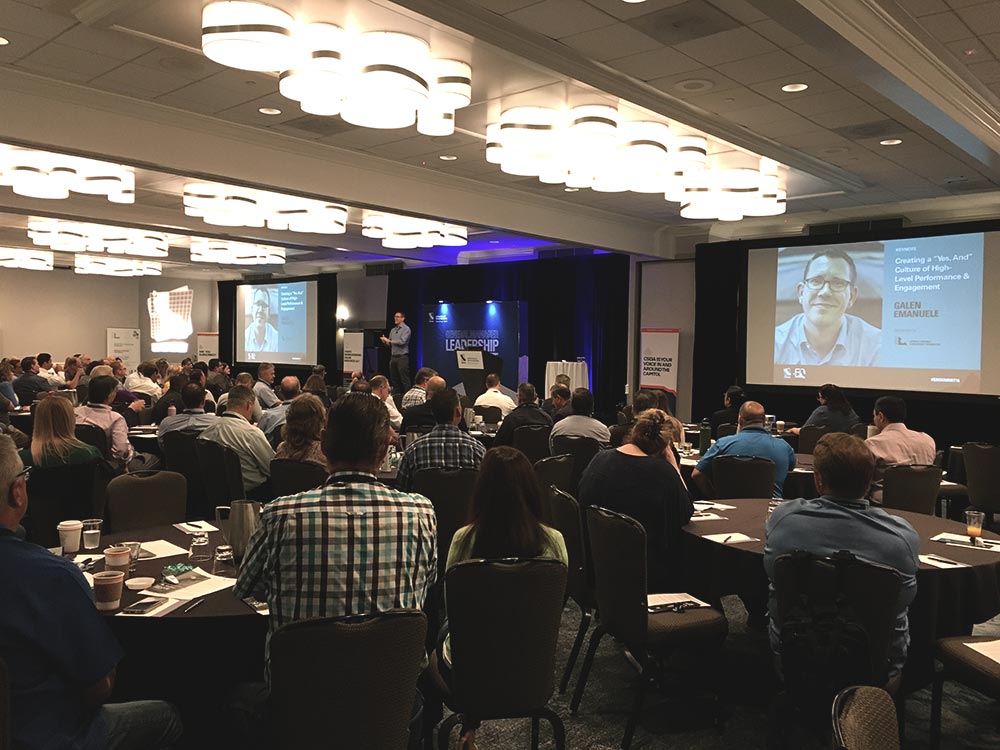
Galen’s dynamic session captured the audience at CSDA’s 2019 General Manager Leadership Summit. It profoundly impacts the way you communicate, show up, and lead your team. Through simple, skill-building activities, Galen led how to create a cohesive “Yes, And” culture to skyrocket team performance and engagement. The audience laughed and learned, and came away with new, powerful tools to enhance their leadership abilities, self-awareness, emotional intelligence, and the capacity to drive exceptional culture within your organization.
Culture: It’s Not Just for Breakfast Anymore
As a speaker and expert on leadership and teams, I spend my days working with organizations, getting to see firsthand the dynamics and challenges associated with running a business. And in my experience, no matter the industry, business model, or size, from retail to manufacturing to hospitals; there is one commonality that determines success over struggle: organizations that prioritize culture are winning.
For the most part, companies spend their time and energy focused on developing and executing business strategy. For many, company culture is just something they hope to get right, often waiting to address it until it’s broken and the consequences become too costly to keep ignoring. Business visionary and author, Peter Drucker, famously said, “Culture eats strategy for breakfast.” This quote couldn’t be more on the money.
 The Case for Culture
The Case for Culture
The most critical mistake an organization can make is to overlook the importance of culture and simply leave it up to chance. Culture is less visible and tangible on the surface than metrics like sales numbers, which makes it easy to slip down the ladder of priority. But make no mistake: the negative impact of poor company culture is destructive to every aspect of an organization and its bottom line. Employee engagement, job performance, turnover, quality control, customer experience and loyalty, just to name a few.
I’m not just speaking from the heart, there’s unlimited data to support this reality.
According to a Gallup Report on the State of the American Workplace, companies that made a concerted effort to focus on culture and employee engagement outperformed companies that didn’t by 10% in customer ratings, 22% in profitability and 21% in productivity. Those companies also saw a 25% decrease in turnover and shrinkage and saw almost a 50% decrease in safety incidents throughout the year.
If that’s not enough to convince you, that same report shared that companies who dedicated time and resources to building and cultivating a positive company culture resulting in highly engaged employees outperformed their peers by 147% in earnings per share. Similarly, the Workplace Research Foundation proclaims that increasing investment in culture and engagement by just 10% can increase your profits by $2,400 per employee on an annual basis.
Flat out, culture is good for business. And companies that still need convincing are being left in the dust.
Where Companies Fail
The fact is that even though companies may be aware of this reality, only about 25% of organizations today have an employee engagement and culture strategy in place, and toxic work culture is rampant. We have all either experienced it, left a job because of it, or know someone who’s life is currently miserable due to it.
While things like great compensation go a long way to move the needle and improve workplace environment, it’s not enough to just throw money at people and stick a ping pong table in the break room. The hard truth is that you can’t pay someone enough to stay at a job they hate. When it comes down to it, culture matters more.
So yes, it’s important. Yes, you’re leaving money on the table if you don’t address it. And yes, your employees will leave if they don’t feel engaged (and you’ll be stuck with the tab -- which is typically 100 - 300% the cost of the employee’s annual base salary, according to Gallup).
So the question is, how can you actually create and effectively drive culture in an organization?
There is a way. Just know this with absolute certainty: hanging a poster on the wall expressing your company’s core values does nothing to actually impact culture. As you may have heard, the values displayed in the lobby of Enron, the company bankrupted by fraud and whose leaders went to jail, were Integrity, Communication, Respect, and Excellence. So there’s that.

The actual answer here is simple and indisputable:
You must treat culture as a strategic priority. You must create a plan.
No company in the world leaves anything critical to the business up to chance. When faced with having to successfully market a brand, we develop a sophisticated marketing strategy. We define an executable plan based on desired outcomes and then put that plan into action. We don’t rely on hope for great sales results, we make sales a strategic priority. Same with finance, operations, IT, customer service, etc.
For the love of all that’s good in the world, do not risk banking your company culture on hope. We have to approach culture the same we approach any goal where we want to achieve success: define it, create an action plan against it, and execute it. To create and drive an awesome culture you have to ask the right questions and get clear on the answers.
Here’s a six step guide to help build a strategic culture plan for your company. The questions included are by no means comprehensive, but they’re a jumping off point to spark conversation and define your culture plan.
- What’s your driving story?
What’s your company story, why do you do what you do? When people show up, what are they contributing to? If everyone in the organization is holding an oar, this is why they row and what they’re rowing towards.
- Articulate your values in practice.
Define the values that drive your behavior as a company. Use action words. If you say integrity, get specific and clear about what integrity looks like in action. These are your ground rules to how you behave, not merely what you believe.
- Employee experience.
Outline the experience of your people. What do want it to feel like to be part of the team? What will employees tell their friends and family about how it feels to work there?
- Traditions.
Identify what systems and traditions you’ll embrace to integrate and support this plan. This can include hiring practices, coaching and evals, training, company events, reward programs, how you start meetings, etc.
- Success & accountability.
Define your commitment as a team. What is expected of leaders and employees, how do you hold each other accountable? How do you measure your success, and how often? Most importantly, do you mean it: is anyone exempt from showing up this way?
- Capture the beating heart.
Now that you’ve outlined it, define the essence of your culture in one sentence or idea. Brand it. What’s the heart of it? How would you describe your culture to someone outside of the organization?
 What Next?
What Next?
Now that you’ve created your strategic culture plan, share it with your team. Talk to them about the experience of creating this plan, ask for feedback, and share the next steps as a result. There’s no better way to make progress, be accountable, and get buy-in than involving them in this work.
Prioritizing culture is not a nice-to-have, it’s a must have. It is your competitive advantage and your way forward as a business. Ultimately, your focus on culture as a strategic priority will set you on a path to success, and those efforts will be felt throughout your organization. Your employees will be happier, your customers will be happier, your bottom line will be happier.